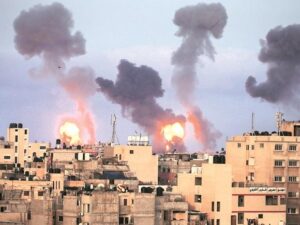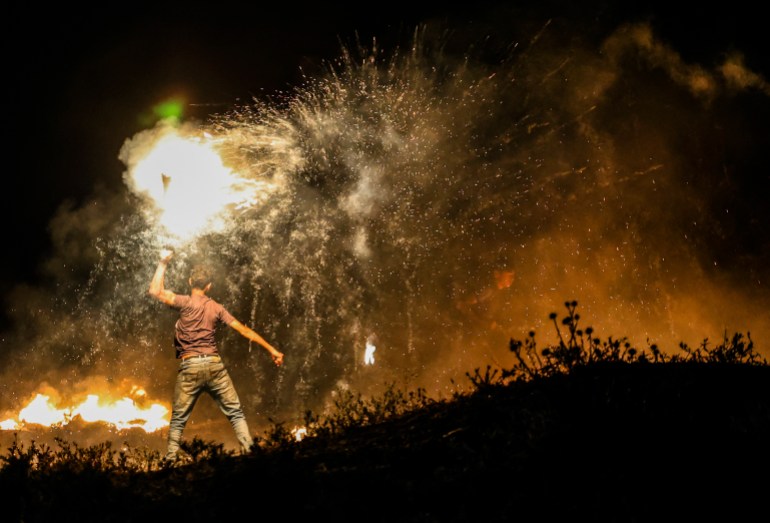
Israeli air strikes are the first on Gaza since a shaky ceasefire with Hamas ended 11-days of fighting last month.

Israel launched air raids on the Gaza Strip after Palestinian groups in the besieged enclave sent incendiary balloons into southern Israel.
The overnight air strikes gave way to calm by morning, and there were no reports of casualties on either side.
The raids early on Wednesday come less than a month after Israel’s 11-day bombardment of Gaza in May and followed a march in occupied East Jerusalem by Jewish nationalists that drew Palestinian condemnation and anger.
The Israeli military said its aircraft attacked Hamas compounds in Gaza City and the southern town of Khan Younis and said it was “ready for all scenarios, including renewed fighting in the face of continued terrorist acts emanating from Gaza”.
The raids, the military said, came in response to the launching of the balloons, which caused 20 blazes in open fields in communities near Gaza.
A Hamas spokesman, confirming the Israeli attacks, told Reuters news agency that Palestinians would continue to pursue their “brave resistance and defend their rights and sacred sites” in Jerusalem.
Israel’s Army Radio reported that Israel informed Egyptian mediators that direct Hamas involvement in the fire balloon launch would imperil long-term truce talks.
Al Jazeera’s Safwat al-Kahlout, reporting from Gaza, said Palestinian fighters said they had no orders from their commanders to respond to the latest raids.
He also noted Hamas did not mention retaliation or a response in their statement confirming the Israeli bombardment.
The Israeli raids come two days after a new coalition government, headed by right-wing nationalist Naftali Bennett, took power on Sunday, ending Benjamin Netanyahu’s 12-year run as prime minister.
The new government on Monday approved a “provocative” march by Israeli far-right nationalists and pro-settler groups through occupied East Jerusalem. Thousands of people, waving flags and some chanting “Death to Arabs” paraded in East Jerusalem on Tuesday, drawing anger and condemnation from Palestinians.
In a scathing condemnation on Twitter, Foreign Minister Yair Lapid said those shouting racist slogans were “a disgrace to the Israeli people”, adding: “The fact that there are radicals for whom the Israeli flag represents hatred and racism is abominable and unforgivable.”
 A Palestinian protester throws a burning projectile during a demonstration east of Gaza City near Israel on Tuesday as Israeli ultranationalists marched in Jerusalem’s Old City
A Palestinian protester throws a burning projectile during a demonstration east of Gaza City near Israel on Tuesday as Israeli ultranationalists marched in Jerusalem’s Old City
The “March of the Flags” marks the anniversary of Israel’s 1967 occupation of the city’s eastern part, and came as tensions remain high over Israel’s planned forced displacement of Palestinian families from the neighbourhood of Sheikh Jarrah.
In advance of the march, Israeli police forcibly removed dozens of Palestinians from outside the Old City’s Damascus Gate. At least 17 Palestinians were arrested and 33 others wounded as Israeli police fired stun grenades in the surrounding areas of Damascus Gate.
In May, Israeli air raids in Gaza killed at least 256 Palestinians, including 66 children, while rockets launched by Palestinian groups killed at least 12 people, including two children. The escalation ended after 11 days with an internationally brokered ceasefire.
Mansour Abbas, whose United Arab List (Ra’am) party is the first Arab faction to join an Israeli coalition, said Tuesday’s march was “an attempt to set the region on fire for political aims,” with the intention of undermining the new government.
Abbas said the police and public security minister should have canceled the event. “I call on all sides not to be dragged into an escalation and maintain maximum restraint,” he said.
In past years, the march passed through Damascus Gate and into the heart of the Muslim Quarter, a crowded Palestinian neighbourhood with narrow streets and alleys. But police changed the route on Tuesday to avoid the Muslim Quarter.
Instead, the route went around the ancient walls of the Old City and through Jaffa Gate, a main thoroughfare for tourists, and towards the Jewish Quarter and Western Wall, the holiest site where Jews can pray.
Damascus Gate is a focal point of Palestinian life in occupied East Jerusalem. Palestinian protesters repeatedly clashed with Israeli police over restrictions on public gatherings during the Muslim holy month of Ramadan in April and May.
Those clashes spread to the Al-Aqsa Mosque compound, a flashpoint site sacred to Jews and Muslims. Tensions at the time were further fueled by protests over the threatened eviction of dozens of Palestinian families by Jewish settlers, also in Jerusalem.
